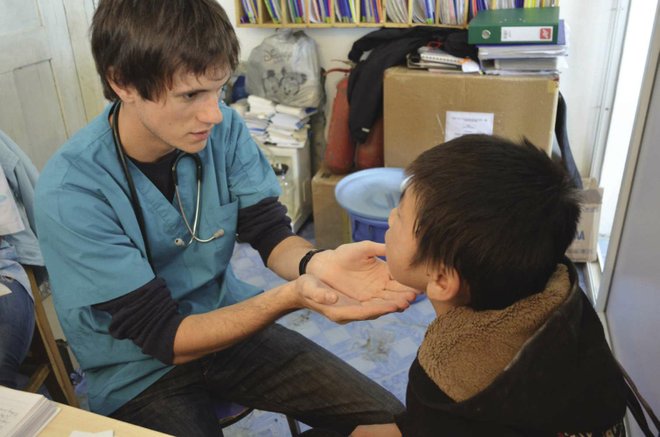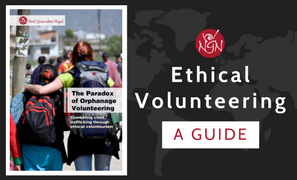What’s your idea of the perfect vacation? Is it lying on a beach, tanning and gazing at the lapping waves? Or skiing through fresh powder on a snowy mountain?
Or might it, instead, involve digging a well in a poor village, teaching English to a group of foreign schoolkids or lugging bales of hay to feed elephants at an animal rescue shelter?
If you lean more toward the latter, you might just be a voluntourist (a mashup of volunteer and tourist) – part of the fastest-growing segment of the global travel industry, a multibillion-dollar cash cow involving millions of do-gooder travelers willing to spend their leisure time and money to help the world’s needy. It may seem like a win-win situation for all involved, but, considering that most voluntourists are unskilled and many projects fail to make a lasting impact, the jury is still out on whether voluntourism is a boon – or a bane – for the communities it purports to serve.
Voluntourists’ reasons for trekking abroad are varied. One might desire to experience a foreign country more authentically than they could at an all-inclusive resort. Another could be a college student filling in a gap year and looking to add volunteer work to a resume. A third might be someone with a genuine altruistic desire to improve the world. Whatever their motivations, millions are opting to hike the voluntourism trail these days.
Dr. Nancy Gard McGehee, professor of hospitality and tourist management at Virginia Tech, estimated in 2015 that the voluntourism industry was worth up to $2 billion with 10 million vacationers involved in it annually. Volunteer Tourism Views estimated that, by 2020, 25 million to 30 million vacationers a year will choose to spend their holiday time doing volunteer work.
However, Dr. McGehee notes that voluntourism is a broad term encompassing many different types of travel, so it’s difficult to put a precise number on the value of the industry.
“I don’t think anybody can say with any amount of confidence as to what the dollar value is,” she says. “There are hundreds of travel companies promoting voluntourism. It’s not regulated.”
Pippa Biddle is a writer whose upcoming book, “Ours to Explore: Privilege, Power and the Paradox of Voluntourism,” is set for publication in 2020 by the University of Nebraska Press. She says that a commonly quoted value of the industry is $2.6 billion annually.
“The problem with that number is that I think it’s a lowball,” she says. “It is a big multibillion- dollar industry – the question is how big.”
Search “voluntouring” online, and more than 20,000 results pop up, including many agencies anxious to sell you a voluntouring vacation package. Their websites are filled with photos of travelers smiling with local children in foreign countries, weeding stone steps on the Inca Trail in Peru or clearing a site for a new playground in Jamaica.
Discover Corps in San Diego, one of the largest agencies, offers an eight-day trip to Belize to help monitor the manatee population, priced at $2,995, which also features visits to waterfalls and tours of Mayan ruins. Or you might help develop learning materials in Guatemalan schools on an eight-day vacation costing $1,995 – while staying in three-star hotels.
Discover Corps got into the voluntourism business about six years ago, focusing on family- oriented trips and typically combining volunteer work with regular vacation-type activities. It has sent thousands of tourists on volunteer excursions since then.
“Voluntourism is profitable because people want these experiences,” says Amanda DiSilvestro, marketing manager of Discover Corps. “People are becoming more conscious of how they spend their time and where they put their money. It feels good to know that even your presence there is making a difference.”
Projects Abroad, based in New York and Toronto, has been offering voluntourism travel for about 25 years and has sent more than 100,000 volunteers to projects in 38 countries. The company specifically designs projects for gap year students and high school groups as well as those interested in teaching; helping with sports; aiding in archaeology projects in Romania and Peru; or assisting in building projects in Ghana, Jamaica, Nepal, the Philippines, Senegal, South Africa and Tanzania. Projects Abroad offers more 1,000 volunteer project options.
Volunteers often live and eat with host families. Projects Abroad has more than 600 staff members who live in each country where projects are underway to assist volunteers. Trip prices range from under $2,000 to more than $5,000 – plus airfare – depending on the duration and type of trip.
The organization takes great pride in noting that 230 of its volunteers helped rebuild seven schools and a day care center in the Philippines after the destruction of Typhoon Haiyan in 2013. They also launched literacy programs in 26 schools in 12 countries in 2015.
Kim Jack Riley, regional sales director for Projects Abroad, says the company thrives on offering something for everyone in voluntourism.
People take these trips for two reasons, she notes: They “really want to do good and see good in the world,” and “people love to travel. Volunteering abroad has become a method of combining those for people.”
The continued growth of voluntourism seems assured according to a recent study by Marriott Rewards Credit Card, which found that millennials are much more likely to consider a voluntourism vacation than baby boomers or Gen X travelers. The study also found that 28 percent of female travelers would be likely to take a voluntourism trip, compared to 17 percent of male travelers.
In 2012, the Adventure Travel Trade Association released a study that found that more than half of its member agencies, 55 percent, were running voluntourism programs, while 41 percent of the rest were considering adding voluntourism trips.
At that time, voluntourists were 53.21 percent female and 46.79 percent male, and the most popular volunteer programs involved children, education, environmental protection or recovery, wildlife recovery, job creation and clean water.\
Via International is a nonprofit travel organization based in San Diego that has sent volunteers to Sri Lanka to repair the damages of war and to Mexico to install water filters for catching and reusing rain water. The group has donated 400 beehives, planted 600 community gardens and 10,000 home gardens, and given nutritional education to 80,000 women and children.
“We try to have the projects be community defined,” says Elisa Sabatini, president of Via International. “We don’t just go in and say, ‘We think you need something.’ We say, ‘This community has identified something they need.'”
Despite the feel-good message marketed by these groups, voluntourism has come under heavy criticism. While some organizations are doing work that is genuinely beneficial, others merely make empty gestures of helping – with no positive results, according to critics.
Money inevitably corrupts systems. UNICEF found that 77 percent of “orphans” in Cambodia had at least one living parent, and many were being used to attract voluntourism dollars. Lumos, an NCO founded by “Harry Potter” author J.K. Rowling, found that 80 percent of children in orphanages worldwide were not actually orphans. One of the world’s largest group voluntourism agencies, World Challenge, decided last year to halt orphanage visits altogether so as not to support such facilities.
“Not to say every single orphanage is abusing children or putting children in harm’s way, but it has been found that enough of them are doing it to make it deeply concerning, especially when we already know that institutionalization is negative for children,” Biddle says.
Experts also note that volunteers often are unskilled, do poor work and take paying work away from local workers.
“There is this idea that, because you speak English, you are qualified to teach English,” Biddle says. “That is not true in the U.S., so why are we holding that standard for other places?”
Voluntourists often stay in foreign-owned hotels and eat at foreign-owned restaurants and thus fail to contribute to the local economy.
A for-profit tour agency offering voluntourism options must still focus on the leisure wishes of its paying clientele – often at the expense of developing truly effective programs in local communities. The trips sometimes become more about the “tourism” than the “volunteering.”
“As long as a company’s bottom line is based on pleasing a customer who is not in the community, they are predisposed to provide experiences that most benefit the traveler,” Biddle says. “Even for a nonprofit, if their money is coming from a traveler, even with the best of intentions, they need to keep that traveler paying.”
Thus, experts advise contacting a volunteer project directly to arrange a voluntourism trip rather than going through an agency. That way, you can rest assured that the work you’re doing is truly benefiting the intended cause and not just lining the pockets of agencies looking to lure naïve travelers. Such agencies are held to no standards – ethical or otherwise – because voluntourism “is an unregulated phenomenon. There’s no protection there,” says Dr. McGehee.
But voluntourists keep coming, says Marisa Johnson of voluntourism group Empowering The One.
“People want connection. They want purpose. That’s what you get when you are voluntouring. You get a sense that you made a difference in this world. You left your mark and made a difference in somebody’s life – a real difference.”






